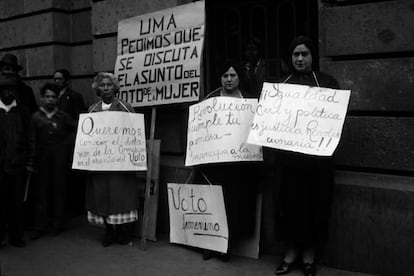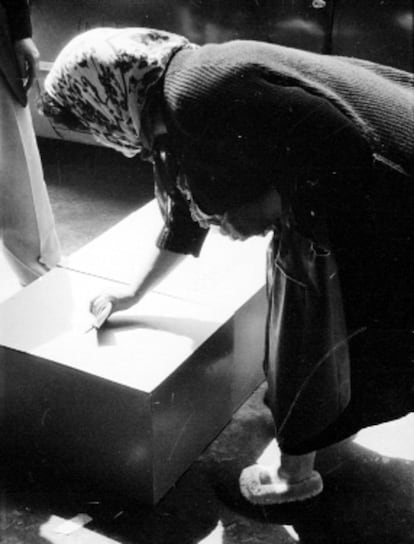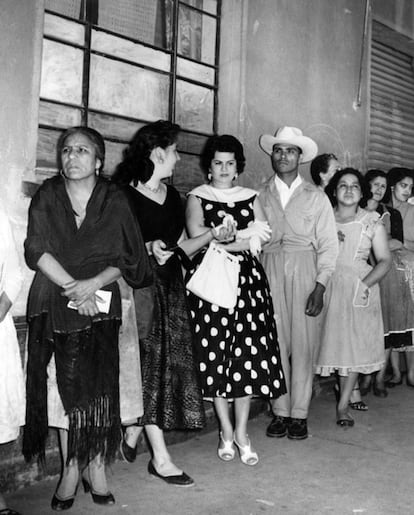Mexican women’s long journey to win political rights
The election of the first female president in Mexico represents an important achievement in female representation, but experts warn that ‘there is still a long way to go to achieve equality’


Claudia Sheinbaum went to her voting center on Sunday and marked her ballot with the name of Ifigenia Martínez, the first Mexican woman to graduate from Harvard University with a master’s degree and doctorate and one of the first women to reach a position of responsibility in Mexico’s public administration. Martínez — one of the most influential women in Mexico — is also founder of the Party of the Democratic Revolution (PRD) and a senator in Congress.
Sheinbaum’s symbolic vote was a nod to the women who have forged the path for women to win their political rights. A tortuous path full of violence and blood, in which despite the achievements achieved so far, there are still problems with gender equality, the economic independence of women, sexist violence and femicides. The big question now is whether the fact that Sheinbaum has been elected Mexico’s first female president will translate into more political rights and protection for women in Mexico, where 11 women are murdered a day.
Martínez’s is a name that weighs heavily in the history of the battle for women’s rights. She was committed to social movements, as seen on the night of September 17, 1968, when the Mexican army stormed National Autonomous University of Mexico’s (UNAM) University City, and Martínez — then director of the UNAM School of Economics — did not hesitate to defend the autonomy of the largest educational institution in Latin America. Martínez was detained and locked up in a Mexico City police cell, near Plaza Tlaxcoaque, which was infamous as a torture center.
The story is an example of the courage of a woman who paved the way for other women to occupy positions of power in Mexico, a deeply sexist country. Although Sheinbaum is the first woman to lead Mexico, other women have also dared to break the glass ceiling. The first of them was the human rights defender Rosario Ibarra de Piedra, who presented her presidential candidacy for the Workers’ Revolutionary Party (PRT) in 1982. In 1994, Cecilia Soto became the second woman to run for president. She was followed by Marcela Lombardo Otero, Patricia Mercado, Josefina Vázquez Mota and Margarita Zavala, who ended up stepping aside before the 2018 elections. This year, Sheinbaum and Xóchilt Gálvez joined that list.
The first great political achievement: the right to vote
The first great political achievement of women occurred, albeit belatedly, in October 1953, when, under the mandate of president Adolfo Ruiz Cortines, the constitutional reform recognizing women’s right to vote and be elected to public office was published in the Official Gazette of the Federation.
The milestone, however, was not free of controversy and violence. “In the national elections of July 3, 1955, women went to the polls for the first time to cast their vote; However, although in the legal framework women’s political rights had been recognized, many of them suffered a severe degree of family repression that prevented them from going to vote, much less participating in the public sphere of power,” states the History of the Political-Electoral Rights of Women in Mexico, published by the Electoral Tribunal of the Federal Judiciary (TEPJF).
Women’s fight for the vote began a century earlier. The battle is linked to the French intellectual Laureana Wright, who first claimed women’s suffrage at the end of the 19th century in what is considered the first Mexican feminist newspaper: Las Violetas del Anáhuac. “The beginning of feminism in Mexico can be dated to the appearance of this type of magazines made by women for women, although they are elite women, who have access to education and certain economic resources, which allows them to develop these activities,” explains Jessica Méndez, who has Ph.D. and Master’s Degree in Modern and Contemporary History.

The beginning of the suffragette movement
Méndez explains that the feminist movement achieved greater weight during the Mexican Revolution, with the proliferation of so-called clubs that opposed the reelection of Portfirio Diaz, a campaign launched by Francisco Madero. “They were exclusively women’s clubs that supported Madero’s activities, and in their meetings one of their demands was that their right to vote be recognized. They actively participated like any other citizen, but without having the recognition of their political and civil rights,” says the academic.
This is, she adds, the beginning of the suffragette movement in Mexico, which developed in the 1920s from various women’s groups. “They differ in terms of their political positioning, but they agree that the right to vote is a central demand, because they identify that political participation will allow them to promote other series of rights, because the vote gives them the status of citizens,” says Méndez.
Hermila Galindo’s name is linked to the suffragette movement. Her personal story is also an example of the violence and prejudices that women faced (and continue to face) in their demand for political participation. Galindo directed the magazine La Mujer Moderna (The Modern Woman), which tried to campaign for women’s rights, mainly in access to education.
Galindo faced patriarchal political power in 1917, when she called for women to be allowed to vote in the Constituent Congress of Querétaro, a request that was denied. In response, she decided to run to be a federal deputy, which sparked public contempt. “She was reviled by newspapers and other politicians, including her fellow constitutionalists,” says the TEPJF article. Despite this contempt, Galindo participated in the March 1917 elections, although she did not win. She conceded defeat, but also “denounced irregularities and the attacks [nowadays political violence] that she suffered before, during and after the day,” states the TEPJF.
But Mexican women did not allow themselves to be defeated by these setbacks. In January 1916, the First Feminist Congress was organized in Yucatán, one of the most conservative states in Mexico, and a year later the Family Relations Law was approved, which established that men and women had equal rights within the home, although it did not explicitly grant political rights to women. It was almost a decade later, in 1925, that authorities in Chiapas, a state in the southeast of the country, granted women over 18 the same political rights as their male counterparts. Suffragette Elvia Carrillo ran for public office and was elected, but state authorities did not recognize her victory, as suffrage and the right to hold elective office were still restricted to men. In 1936, in the state of Veracruz, María Tinoco and Enriqueta de Pulgarín ran as local deputies taking advantage of a legal loophole, and a year later, president Lázaro Cárdenas, promoted a reform of Article 34 of the Mexican Constitution. It was, however, never enacted or published in the official journal.

In 1946, that the Chamber of Deputies approved an initiative to allow women to participate on equal terms in municipal elections, but it wasn’t until 1953 that women obtained the right to vote.
The struggle of women for their political rights intensified in the new democratic era. Thanks to pressure from civil society organizations, the Parity Law was approved in 2014, mandating 50% gender parity in candidate nominations. And in 2019 a constitutional reform was approved to ensure gender parity in federal positions, both at the state and municipal level, as well as in the legislative and judicial branches.
Patriarchy in politics
Mexican women who want to run for public or popularly elected positions still face obstacles. Méndez points to the cast of the so-called Juanitas, women who were nominated by political parties in order to comply with gender quotas, but forced to resign from their positions once the election was won. A man would then take their place. “We see that, even when the law is in place, there are certain gaps, legal loopholes, that leave women’s rights unprotected,” says the academic.
The differences are more noticeable in inland Mexico and among Indigenous populations. There, women must confront the practices and customs that govern their communities and that generally ignore what is established in federal laws. “We have made a lot of progress in regulations. Article 2 of the Constitution establishes that even in localities in which the use and custom or methods of traditional political systems for the appointment of public positions are recognized, there must be parity, but the reality is that there is a lot of patriarchy in these communities, especially in the state of Oaxaca, where an extension has even been requested to push back the application of these regulations,” says Adriana Báez, an academic at the UNAM Faculty of Political and Social Sciences.
“Women’s problems are not only political,” adds Báez. “Of course it is important that we are in positions of power, but it is more important that they let us participate equitably in decision-making. We are also interested in making progress on issues such as equal pay and addressing different types of violence against women.” Méndez, for her part, points to other urgent needs such as expanding shelters for women who suffer gender violence, guaranteeing food pensions and achieving women’s economic independence. She warns: “Undoubtedly the election of a woman is an important achievement in the representation of women in the public sphere, but there is still a long way to go to achieve equality.”
Sign up for our weekly newsletter to get more English-language news coverage from EL PAÍS USA Edition










































